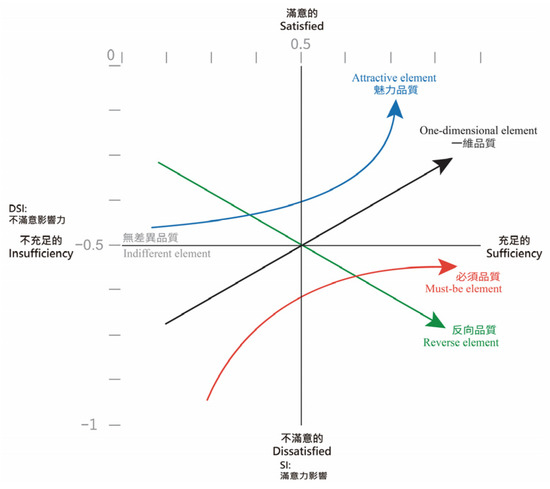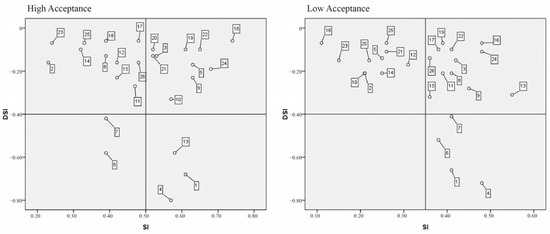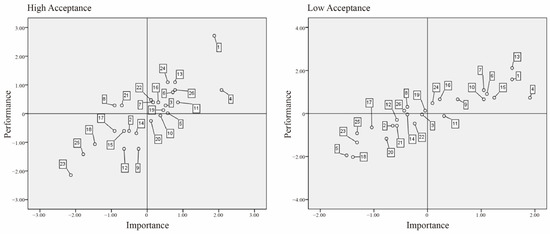Abstract
Since the COVID-19 pandemic, synchronous distance learning has become a common teaching method. However, there are problems in synchronous distance learning, such as distractions and cheating. Many studies have shown that gamification has been used as one way to improve student’s learning motivation. Thus, we explored the functional requirements of synchronous distance learning software and different distance learning acceptance with gamification elements by students using KANO and an importance-performance analysis. The results of the study showed that most students thought it important to integrate games into synchronous distance learning, and gamification brought more fun to learning while achieving the purpose of learning.
1. Introduction
The COVID-19 pandemic caused school closures globally in 2020, with 107 countries shutting down schools, as reported by UNESCO. While synchronous distance learning became the new norm, it faced challenges such as decreased interaction between students and teachers [1]. To overcome these challenges, digital game-based learning was used to enhance such interactions. Studies have shown that a competitive gaming environment can increase students’ motivation, academic performance, and gamification elements in synchronous distance learning, improving student focus and interaction [2,3]. By analyzing 15 basic functions of synchronous distance learning software from Google Meet and Microsoft Teams and 11 gamification elements from digital game learning software such as Blooket and Duolingo, we assessed students’ attitudes toward the different functions of these elements. For this research, the KANO and importance-performance analysis (IPA) questionnaires were used. The results of this study serve as a basis for future research.
2. Research Background
2.1. Gamification
Deterding, Dixon, Khaled, and Nacke defined gamification as the “integration of game design elements into non-game contexts” [4]. Using gamification aims to increase user engagement and immersion by incorporating elements of game design such as mechanics and game flow. Gamification also changes the way an event or process operates, making it more captivating and enjoyable for the user.
2.2. Synchronous Distance Learning
Synchronous distance learning means that teachers and students conduct online teaching and learning in different places through media, such as the Internet and video software [5]. Due to the COVID-19 pandemic, Microsoft Teams and Google Meet were widely used in teaching.
2.3. KANO Model
The KANO two-dimensional quality model is a tool that can evaluate the quality of functions or services. It was developed by Noriaki Kano in 1984 to provide a way to help organizations understand the needs and preferences of their customers [6]. The KANO model categorizes customer requirements into five distinct categories based on feedback from existing and potential customers. The model identifies what features are important to their customers and makes informed decisions on product or service development. These five categories are as follows (Figure 1).

Figure 1.
KANO two-dimensional quality model, adapted with permission from Ref. [6]. Copyright 1984 Kano.
- Attractive element (A): Adequate presence enhances satisfaction, while an inadequate presence is still acceptable.
- One-dimensional element (O): More of this quality leads to greater satisfaction, while fewer leads to less satisfaction.
- Must-be element (M): Adequate presence is expected, while inadequate presence leads to dissatisfaction.
- Indifferent element (I): The presence or absence of this quality does not impact satisfaction.
- Reverse element (R): Adequate presence causes dissatisfaction, while absence leads to satisfaction.
2.4. Classification of Kano 2-Dimensional Quality Elements
Matzler and Hinterhubery improved the Kano model by introducing a “Two-Dimensional Quality Element Classification Table” [7]. This table can categorize relative quality elements based on responses to forward and reverse questions (Table 1).

Table 1.
Two-dimensional quality element classification table of the KANO model, adapted with permission from Ref. [7]. Copyright 1998 Matzler and Hinterhuber.
2.5. Quality Improvement Index
Matzler and Hinterhube introduced the Quality Improvement Index (QII) [7] to prioritize the quality elements that require improvement. QII comprised two components: the “Satisfaction Index (SI)” and the “Dissatisfaction Index (DSI)”. They formulated the calculation of the QII as follows.
SI = (A + O)/(A + O + M + I)
DSI = (O + M)/(A + O + M + I) × −1
QII can be used to determine which quality elements need improvement. The higher the SI value is toward one, the greater the impact it has on customer satisfaction. On the other hand, the closer the DSI value is to −1, the stronger the negative impact it has on customer satisfaction when quality is insufficient.
2.6. IPA
Martilla and James introduced the IPA analysis [8], which is a valuable and practical set of analytical methods to understand consumers’ perceptions of product and service quality. This result provides a foundation for evaluating and improving perception. By using satisfaction and significance as evaluation criteria, a two-dimensional matrix graph was created and divided into four quadrants (Figure 2). Quadrant 1 was for “Keep Up the Good Work”, which signified customers’ high satisfaction and the high importance of the project, making it a strength of the company. Investment should be sustained to maintain its competitive edge. Quadrant 2 was for “Concentrate Here”, highlighting low satisfaction but the high importance of the service, making it crucial to improve. Quadrant 3 is for “Low Priority”, depicting the low satisfaction and low importance of the service, making it a low priority for improvement. Quadrant 4 is for “Possible Overkill”, suggesting the high satisfaction but low importance of the service, indicating the potential to reallocate resources to more critical areas.

Figure 2.
IPA model, adapted with permission from Ref. [8]. Copyright 1997 Martilla and James.
3. Research Methods
We distributed questionnaires to students and graduate students (19 to 25 years old) of the Yunlin University of Science and Technology in Yunlin County, Taiwan, through Google Forms. A total of 60 valid questionnaires were collected. The research questionnaire consisted of three parts on a 5-point Likert scale (“Strongly Agree”, “Agree”, “Neutral”, “Disagree”, and “Strongly Disagree”). The first part was to collect basic information and ask about technology acceptance with an explanation of “trying to understand students’ acceptance of distance learning software.” The second part was created based on the IPA model on a 7-point Likert scale (“Very Strongly Agree”, “Strongly Agree”, “Agree”, “Neutral”, “Disagree”, “Strongly Disagree”, and “Very Strongly Disagree”) to understand students’ subjective feelings about the function. The third part reflected the KANO two-dimensional quality model. According to Matzler and Hinterhuber [7], five evaluation indicators were included for the answers to positive and reverse questions on a 5-point Likert scale (“Like”, “Must-have”, “No-Comment”, “Bearable”, and “Dislike”). SI and DSI were calculated with Equations (1) and (2) as quality improvement indicators.
4. Results
In total, 40 females and 20 males took part in the survey. Thirty-one had a high acceptance of distance learning software, while 29 had a low acceptance of technology. Students with a high acceptance of distance learning software were classified according to the degree of satisfaction and dissatisfaction. The satisfied group showed a high SI for A1, A5, A9, A16, A19, A22, and A24, while the dissatisfied group had a low DSI for A1, A4, A6, and A13. Students with a low acceptance of distance learning showed a high SI for A4, A9, A16, and A24 and a low DSI for A1, A4, and A6 (Table 2).

Table 2.
KANO quality improvement index.
4.1. Kano Two-Dimensional Quality Elements
With the average value of SI and DSI, a quadrant diagram was drawn for the participants of this survey (Figure 3).

Figure 3.
KANO Quality Improvement Index.
The attractive element in Quadrant 1 showed that the participants were satisfied with the software. Even without these elements, they would not feel bad. For students with a high acceptance of distance learning software, A3, A5, A9, A10, A16, A19, A20, A21, A22, and A24 were positioned in Quadrant 1. For students with a low acceptance of distance learning software, A3, A8, A9, A11, A13, A15, A16, A17, A19, A22, A24, and A26 were found in Quadrant 1.
The indifferent element was found in Quadrant 2. The participants were not satisfied or dissatisfied regardless of whether the service or function was available or not. For students with a high acceptance of distance learning software, A2, A8, A11, A12, A14, A15, A17, A18, A23, A25, and A26 were plotted in Quadrant 2, while for students with a low acceptance of distance learning software, A2, A5, A10, A12, A14, A18, A20, A21, A23, and A25 were found.
Quadrant 3 showed the must-be elements. Without this element, the participants were dissatisfied. However, even with this element, the participants were not particularly satisfied as the element was considered a basic service. For students with a high acceptance of distance learning software, A6 and A7 were found in Quadrant 3. One-dimensional elements were positioned on Quadrant 4. The fewer the elements, the more dissatisfied the participants were. However, with this element, their satisfaction increased. For students with a high acceptance of distance learning software, A1, A4, and A13 were plotted on Quadrant 4, while A1, A4, and A6 were found in Quadrant 4 for students with a low acceptance of distance learning software.
4.2. IPA Analysis
According to the IPA results, the quadrant diagram of the high acceptance and low acceptance of distance education software is drawn in Figure 4. For the students with a high acceptance of distance education software, most functions were found in Quadrants 1 and 3. In Quadrant 1, A1, A3, A4, A5, A6, A7, A10, A11, A13, A16, A19, A22, and A26 were found, while A8 and A21 were on Quadrant 2, A2, A9, A12, A14, A15, A17, A18, A23, and A25 were on Quadrant 3, and A10 and A20 were on Quadrant 4.

Figure 4.
Quality improvement index from IPA analysis.
For the students with a low acceptance of distance learning, A1, A4, A7, A6, A9, A10, A13, A15, A16, and A24 were plotted on Quadrant 1, A8, A19, and A26 were on Quadrant 2, A2, A3, A5, A12, A14, A17, A18, A20, A21, A22, A23, and A25 were on Quadrant 3. In Quadrant 4, there was only A11.
5. Conclusions
The KANO model and IPA analysis results revealed that the participants in this study thought that integrating games into synchronous distance learning software was required even though gamification elements were not the main focus for the development of the software. They regarded that gamification enhanced learning experiences by making them more enjoyable and fulfilling and the goal of fun learning. Without gamification, they might feel dissatisfaction. The IPA result revealed that emojis were significant for the participants to use the software. These small yet powerful symbols serve as a crucial medium of communication, and diverse emojis were an element of excitement for the students, thereby elevating their engagement in synchronous distance learning. Additionally, other crucial gamification elements, such as achievements, exchange mechanisms, and gamified dashboards, must also be prioritized for development.
Author Contributions
All authors contributed equally to this work. All authors have read and agreed to the published version of the manuscript.
Funding
This research was funded by [National Science and Technology Council, R.O.C], grant number [NSTC 111-2410-H-224-021].
Institutional Review Board Statement
Not applicable.
Informed Consent Statement
Not applicable.
Data Availability Statement
Not applicable.
Conflicts of Interest
The authors declare no conflict of interest.
References
- Leontyeva, I.A. Modern Distance Learning Technologies in higher education: Introduction problems. Eur. J. Math. Sci. Technol. Educ. 2018, 14, 1–8. [Google Scholar] [CrossRef] [PubMed]
- Cagiltay, N.E.; Ozcelik, E.; Ozcelik, N.S. The Effect Of Competition On Learning In Games. Comput. Educ. 2015, 87, 35–41. [Google Scholar] [CrossRef]
- Süme, M.; Aydın, C.H. Design Principles for Integrating Gamification into Distance Learning Programs in Higher Education: A Mixed Method Study. Int. J. Serious Games 2022, 9, 79–91. [Google Scholar] [CrossRef]
- Deterding, S.; Dixon, D.; Khaled, R.; Nacke, L. From game design elements to gamefulness: defining gamification. In Proceedings of the 15th International Academic MindTrek Conference: Envisioning Future Media, New York, NY, USA, 28 September 2011. [Google Scholar]
- Anderson, R.; Beavers, J.; Vandegrift, T.; Videon, F. Videoconferencing and presentation support for synchronous distance learning. In Proceedings of the 33rd Annual Frontiers in Education, Westminster, CO, USA, 5–8 November 2003. [Google Scholar]
- Kano, N. Attractive quality and must-be quality. J. Japan Soc. Qual. Control 1984, 31, 147–156. [Google Scholar]
- Matzler, K.; Hinterhuber, H. How to make product development projects more successful by integrating Kano’s model of customer satisfaction into quality function deployment. Technovation 1998, 18, 25–38. [Google Scholar] [CrossRef]
- Martilla, J.A.; James, J.C. Importance-Performance Analysis. J. Mark. 1997, 41, 77–79. [Google Scholar] [CrossRef]
Disclaimer/Publisher’s Note: The statements, opinions and data contained in all publications are solely those of the individual author(s) and contributor(s) and not of MDPI and/or the editor(s). MDPI and/or the editor(s) disclaim responsibility for any injury to people or property resulting from any ideas, methods, instructions or products referred to in the content. |
© 2023 by the authors. Licensee MDPI, Basel, Switzerland. This article is an open access article distributed under the terms and conditions of the Creative Commons Attribution (CC BY) license (https://creativecommons.org/licenses/by/4.0/).